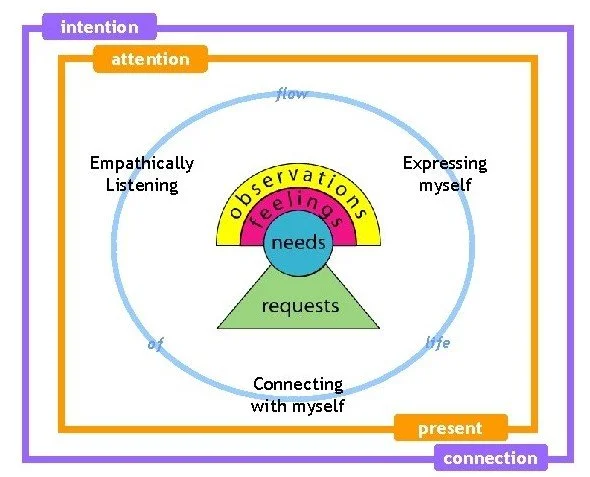A KEY MODEL OF NVC
Within Nonviolent Communication (NVC) there is one basic beginning formula which includes observations, feelings, needs, and requests. These are described in a comprehensive overview of NVC that Bridge Belgrave developed called “A Key Model.” I really appreciate how she explains the basics of NVC and with her permission, I will graciously use her insight to guide my explanation.
Her visual model allows you to see all the parts of the formula and how they interrelate with each other. The more we practice applying the formula, the more we naturally begin to live within the consciousness of NVC and the less it seems like a calculated way of speaking. To shift from our learned ways of language, which is often unsuccessful at meeting our needs, to this new language requires us to make new pathways in our brains. We have been trained to react out of fear and repeat our responses. To undo this cultural programming NVC offers us a love program to run instead, to guide us towards enriching our lives with our heart’s desires. So many of us have such beautiful intentions about who want to show up as often inspired by our childhood’s religious or spiritual ideals of human behavior, then we open our mouths and find that “living that love” is more complicated than we thought.
Our formula has: 2 frames, 3 modes, and 4 ingredients
Frames are used to remind our eyes to focus within the frame to appreciate the art within. NVC encourages us to make a mental frame of our intention, to become very clear about what we want to create and that is connection.
Intention = Connection
When we are connected, we are holding everyone’s needs equally. This connection then leads to these needs being met peacefully.
My intention as I write this; is to stay connected with the needs alive within myself, contribution, sharing, and peace, and also the needs that I am guessing could be alive within a reader, clarity, understanding, and exploration. I hope to contribute to your need for understanding this process. I hope to honor my own need for sharing through my explanation of this process. One way to ingrain our intention is to simply say to ourselves before beginning a conversation, “My intention is connection.”
Our second frame, nested inside our intention, helps us create this connection by bringing our attention to the present. This can be challenging because often our past experiences with someone resurfaces in our memories when we interact with them. If I am not operating in the present, I may start to internally re-hash a previous encounter. So my mind is telling me my concocted story of “Maggie” that I based upon her being an hour late to a dinner we had planned together. I am now convinced that she doesn’t consider my feelings or value my time, I am not even sure if she cares about me at all. So regardless of the fact that Maggie is right now trying to create a flow of compassion between us, I am not allowing myself to experience it because I have already told myself a story about how she feels about me, and my brain is fixated on believing it.
Are you willing to be in the now and choose connection?
Would you enjoy being able to look into someone's eyes and receive them??
Surrounding our frames are our modes, representing the continuous flow of communication within our lives. If we are engaged in conversation with someone we are either speaking (expressing ourselves), or we are listening (receiving others). When not engaged in dialogue, we have ourselves to continuously converse/communicate. Maybe inside your mind, it’s a meandering rambling rant of random commentary about everything you encounter, of non-stop swirls of images and ideas, NVC offers some suggestions to enrich this inner experience by actively connecting with ourselves.
Communication is inescapable, even when we sleep our subconscious is telling us a story!
Before I talk about the next ingredient I invite you to take a moment for some reflection and consider what needs motivated you to read this article? Or I could phrase it this way, by reading this article, what are you hoping to gain or experience?
This brings us to the ingredients of the basic NVC formula.
Needs, Feelings, Observations, Request/Strategy
Needs
In the center, we have our needs (values, desires) which are the core or “heart of NVC.” According to NVC, there are seven main categories of needs: connection, physical well-being, honesty, play, peace, meaning, and autonomy.
I could wax poetic and defend with logic the countless compelling reasons why we all want to have our needs met. I think the simplest explanation is when they are met, life is more wonderful and enjoyable, that’s desirable, agree?? They are the motivator behind all our thoughts, words, and actions. They are a common denominator for all humans and you can explore more in this piece, Universal Human Values- What makes our little lights shine.
Feelings
So it makes sense that in this flow of communication, we give consideration to what needs are motivating our choices, so how can we distinguish which ones? Luckily we have clues…and they are our feelings, the language of our soul, as author Neale Donald Walsch describes them. Our feelings let us know whether our needs are being met, they are a quality of be-ing-ness, our expressive response to life. When we can correctly decipher our feelings, they will point us toward our needs that are either being met or not met.
I am feeling exuberant and jubilant, my need for inspiration is being met. I feel frustrated, I am yearning for progress. I’m pissed, I want consideration. For a deeper dive into the preciousness of feelings, you can read this “Empathy, the freedom to feel.”
Observations
So where do these feelings come from? Well, they are stimulated by our experiences, how we perceive them from our senses, and the observations we make about them. NVC distinguishes between making observations instead of evaluations or judgments. Rather than labeling someone or something, or giving our opinion, we clearly state what is or has actually happened with clear unbiased language.
We may begin with a thought like this, “she never listens to me; every time I start to talk to her she interrupts me." Then we can translate that evaluation into an observation, which could sound something like, “while I was still explaining what I found interesting about the movie, she began telling me her opinion.”
When I think about the interaction this way, it is easier to focus on connection and not her implied “wrong” action. And if I truly care about being connected, I care about both of our needs being met. I go through the process this way; carefully making a clear observation, taking time to perceive how I am feeling, then identifying the underlying need motivating behavior.
Here is one way we could express ourselves in this situation, “I notice that when she begins speaking while I am already speaking, I feel discouraged; I really have a need to be heard.”
What if we stop there, do you think my need to be heard will be met??
I think our model needs some stability and a proactive spirit, with a willingness to step out of our comfort zones for the glory of the met value. So far we have cleared away judgments, connected with how we are feeling, and sensed what need of ours is alive within us. Now is the time to make an attempt to live out the fulfillment of that need.
Requests/Strategies
We do this by making requests of ourselves and others or creating a strategy to implement that is believed will contribute to the fulfillment of certain needs.
So in the case of my friend, I could interrupt her with, “Wow it seems we both want to share how we were affected by this movie. I noticed you began speaking before I was finished expressing my thought. I am feeling discouraged because I really value our friendship and for us both to be heard, I am wondering if you would be willing to allow me to complete my thought and then I would be happy to listen to how you felt about it.” Or something simpler/quicker, “I actually had more to say, would you wait for me to finish my thoughts, and then I’ll listen to yours?" Many may say my first version is too wordy and will lose attention before I get my point across. Sadly they have a point, even though we have had all this convenience-making progress, especially since Industrial Revolution, we now spend less time articulately expressing ourselves and attentively receiving others. I don’t care if it’s out of fashion to take my time with our conversation, I’ll hold on to an idealism that we all slow way, way down, and put more effort into aligning our speech with our intentions Which will save humanity an invaluable amount of time avoiding the mistakes and mishaps that miscommunications create, and we will all be much happier not carrying around bitter resentments. Also, there is entirely too much time wasted thinking of all the things you wished you would have said. Investing in quality communication pays off with a more fulfilled future you.
Benjavisa Ruangvaree, via Dreamstime
This process can happen almost completely within your own mind and you can choose whether you want to express it out in the world. When I started practicing NVC I felt uncomfortable altering how I normally spoke. Here is an example. There were times when I would remain passive while with friends that I would describe as being ‘confident & chatty” do the majority of talking in a conversation. Taking a moment to feel my feelings of frustration and despair, wanting these friends to have a genuine interest in me by listening to me, I could empathize with my need for acknowledgment, consideration, and mutuality in our friendship. I may feel scared to speak up when I am feeling this way, however, it gives me great comfort to take a moment to connect with myself and fully honor my feelings and needs.
After more practice with myself and with others, I now feel more confident interrupting a conversation to share when I'm feeling disappointed and desire an opportunity to express myself. I do not always feel that assured. Sometimes I give myself silent empathy and I don't interrupt and other times I allow my frustration to fuel a rant that ends in more pain. I am not out for perfection, only to gently remind myself to return to my intention to live out this language of the heart. The emotional liberation, freedom, and joy that I have experienced in breaking out of our learned ways of speaking have been so powerful that I’ll always keep striving to rewire my brain to run on compassion.



